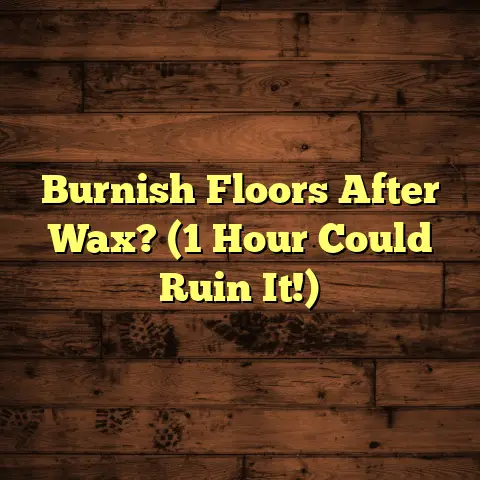How Often Steam Clean Floors? (8 Damage Signs!)
(8 Damage Signs!)
As a flooring contractor, I’ve seen it all – the good, the bad, and the downright dirty when it comes to floors. And believe me, a lot of problems could be avoided with proper cleaning.It’s not just about making your house look nice (though that’s a bonus!). It’s about keeping your family healthy, preventing damage, and saving money in the long run.
Did you know that studies have shown that floors can harbor more bacteria than a toilet seat? Yikes! All those allergens, dust mites, and germs can really impact your health, especially for kids and people with allergies.
And trust me, replacing a whole floor because of neglect is way more expensive than investing in a good steam cleaner and a little elbow grease. So, let’s dive into the world of steam cleaning and figure out how often you really need to do it.
Section 1: Understanding Steam Cleaning
Okay, first things first, what is steam cleaning, and why is it better than just mopping?
Steam cleaning uses hot water vapor to loosen dirt, kill bacteria, and sanitize surfaces. Unlike mopping, which can sometimes just spread around dirty water, steam actually lifts the grime away.
The Science Behind the Steam
It’s pretty cool, actually. The high temperature of the steam (usually around 200°F or 93°C) breaks down the bonds between dirt and the floor surface. Plus, that heat is enough to kill most common bacteria, viruses, and mold spores.
I’ve seen it work wonders on grout lines that were practically black with mildew.
What Floors Can You Steam Clean?
Now, before you go steaming away, it’s important to know what types of floors are safe for steam cleaning. Here’s a quick rundown:
-
Tile: Generally safe, but check with the manufacturer, especially for porous tiles.
-
Hardwood: This is where it gets tricky. Only sealed hardwood can be steam cleaned, and even then, use a low-moisture setting. Too much moisture can warp the wood. I’ve had to repair floors ruined by overzealous steam cleaning.
-
Laminate: Similar to hardwood, laminate can be steam cleaned with caution. Use a low-moisture setting and don’t let water pool on the surface.
-
Vinyl: Usually safe, but again, check the manufacturer’s recommendations.
-
Concrete: Sealed concrete is fine for steam cleaning.
Floors to Avoid
- Unsealed hardwood: A big no-no!
- Cork: Steam can damage the adhesive.
- Some delicate natural stone: Always check first.
Pro Tip: Always test a small, inconspicuous area first to make sure the steam cleaner doesn’t damage your flooring.
Section 2: Frequency of Steam Cleaning
Alright, so how often should you actually steam clean? It’s not a one-size-fits-all answer. It depends on a few factors:
- Usage: How much traffic does the area get?
- Location: Is it a high-traffic zone like an entryway or a low-traffic area like a guest room?
- Environment: Do you have pets? Kids? Live in a dusty area?
Residential vs. Commercial Spaces
Commercial spaces, like offices or restaurants, typically need more frequent steam cleaning than homes. Think about it: hundreds of people tracking in dirt every day versus a few family members.
- Commercial: Aim for weekly or bi-weekly steam cleaning, especially in high-traffic areas.
- Residential: Generally, monthly steam cleaning is sufficient for most homes.
High-Traffic vs. Low-Traffic Areas
High-traffic areas like entryways, hallways, and kitchens will need more frequent attention. I recommend steam cleaning these areas every 2-3 weeks.
Low-traffic areas like guest rooms or formal dining rooms can usually get away with being steam cleaned every 2-3 months.
Homes with Pets or Children
If you have pets or small children, you might want to increase your steam cleaning frequency. Pets bring in dirt, dander, and sometimes… other things. And kids? Well, they’re just messy!
I’d suggest steam cleaning high-traffic areas every 1-2 weeks if you have pets or young children.
Seasonal Considerations
The seasons can also affect how often you need to steam clean.
- Winter: Salt and snow tracked in from outside can be tough on floors. Steam cleaning can help remove that gritty residue.
- Summer: Dust and pollen can accumulate quickly, especially if you have the windows open.
During these times, you might want to increase your steam cleaning frequency.
Here’s a handy table to summarize:
| Floor Type | Traffic | Pets/Kids | Frequency |
|---|---|---|---|
| Tile | High | Yes | Every 1-2 weeks |
| Tile | Low | No | Every 2-3 months |
| Sealed Hardwood | High | Yes | Every 2-3 weeks |
| Sealed Hardwood | Low | No | Every 1-2 months |
| Laminate | High | Yes | Every 2-3 weeks |
| Laminate | Low | No | Every 1-2 months |
| Vinyl | High | Yes | Every 1-2 weeks |
| Vinyl | Low | No | Every 2-3 months |
| Sealed Concrete | High | Yes | Every 1-2 weeks |
| Sealed Concrete | Low | No | Every 2-3 months |
| Commercial Spaces | High | N/A | Weekly or Bi-Weekly |
Remember: These are just general guidelines. Use your best judgment based on your specific situation.
Section 3: The 8 Signs Your Floors Need Immediate Attention
Okay, so you know how often you should steam clean, but how do you know when it’s urgent? Here are eight signs that your floors are begging for some steam cleaning love:
Sign 1: Lingering Odors
Notice a funky smell that just won’t go away, even after regular cleaning? That could be a sign of bacteria or mold lurking in your floors. Steam cleaning can help eliminate those odors by killing the source.
I once had a client who couldn’t figure out why their kitchen always smelled faintly of mildew. Turns out, there was a buildup of grime and bacteria in the grout lines. A good steam cleaning solved the problem.
Sign 2: Visible Stains
Stains are more than just unsightly; they can become permanent if not addressed quickly. Steam cleaning can help lift stains that traditional cleaning methods can’t.
I’ve seen steam cleaning work wonders on everything from coffee spills to pet accidents. The key is to act fast!
Sign 3: Dull Appearance
Is your once-shiny floor looking dull and lifeless? That’s a sign of dirt and grime buildup. Steam cleaning can restore the shine by removing that layer of gunk.
A good steam clean can make your floors look almost brand new!
Sign 4: Allergic Reactions
Are you suddenly sneezing or coughing more often? Unclean floors can be a breeding ground for allergens like dust mites, pollen, and pet dander. Steam cleaning can help reduce these allergens and improve your indoor air quality.
I’ve recommended steam cleaning to clients with allergies, and they’ve reported a noticeable difference in their symptoms.
Sign 5: Mold and Mildew
Mold and mildew are not only gross, but they can also be hazardous to your health. If you see any signs of mold or mildew on your floors, especially in damp areas like bathrooms or basements, steam clean immediately.
Steam cleaning can kill mold and mildew spores and prevent them from spreading. However, for severe infestations, you might need professional help.
Sign 6: Cracks and Splits
Dirt and grime can actually exacerbate existing damage to your floors. If you have cracks or splits in your flooring, steam cleaning can help remove the debris that’s trapped inside and prevent further damage.
I always tell my clients to address cracks and splits as soon as possible. The longer you wait, the worse they’ll get.
Sign 7: Slippery Surfaces
Slippery floors are a safety hazard, especially for children and the elderly. A buildup of dirt, grease, or soap residue can make your floors dangerously slippery. Steam cleaning can remove these substances and restore traction.
I’ve seen too many falls caused by slippery floors. Don’t let it happen to you!
Sign 8: Visible Dust and Dirt
This one seems obvious, but it’s worth mentioning. If you can see dust and dirt accumulating on your floors, it’s time to steam clean! Don’t wait until it becomes a thick layer of grime.
Regular steam cleaning will keep your floors looking their best and prevent the buildup of harmful substances.
Section 4: Consequences of Neglecting Steam Cleaning
So, what happens if you ignore these signs and just… don’t steam clean? Well, the consequences can be pretty serious.
- Costly Repairs: Neglecting your floors can lead to damage that requires expensive repairs or even replacement.
- Reduced Lifespan: Dirt and grime can wear down your flooring materials, shortening their lifespan.
- Decreased Property Value: Dirty, damaged floors can detract from the overall appearance of your home and decrease its value.
- Health Problems: As we’ve discussed, unclean floors can harbor bacteria, allergens, and mold, which can lead to health problems.
I’ve seen it happen time and time again. People put off floor cleaning, and then they end up with a much bigger problem on their hands.
One client of mine had beautiful hardwood floors, but they never cleaned them properly. Over time, the floors became dull, scratched, and stained. Eventually, they had to replace the entire floor, which cost them thousands of dollars.
Another client had a rental property with tile floors that were covered in mold and mildew. The tenants complained of allergies and respiratory problems. The client had to hire a professional cleaning service to remediate the mold, which was a costly and time-consuming process.
Don’t let this happen to you! Investing in regular steam cleaning is a small price to pay for the long-term health and beauty of your floors.
Section 5: Conclusion
Alright, let’s recap. Maintaining clean floors is about more than just aesthetics. It’s about protecting your health, preventing damage, and saving money in the long run.
Steam cleaning is a powerful tool for keeping your floors clean and sanitized. But it’s important to do it regularly and to be aware of the signs that indicate your floors need immediate attention.
Remember those eight signs?
- Lingering Odors
- Visible Stains
- Dull Appearance
- Allergic Reactions
- Mold and Mildew
- Cracks and Splits
- Slippery Surfaces
- Visible Dust and Dirt
If you notice any of these signs, it’s time to break out the steam cleaner!
So, take a look at your floors right now. Are they begging for some TLC? Don’t wait until it’s too late. Evaluate your current floor cleaning practices and make the necessary adjustments. Your floors (and your health) will thank you for it!





